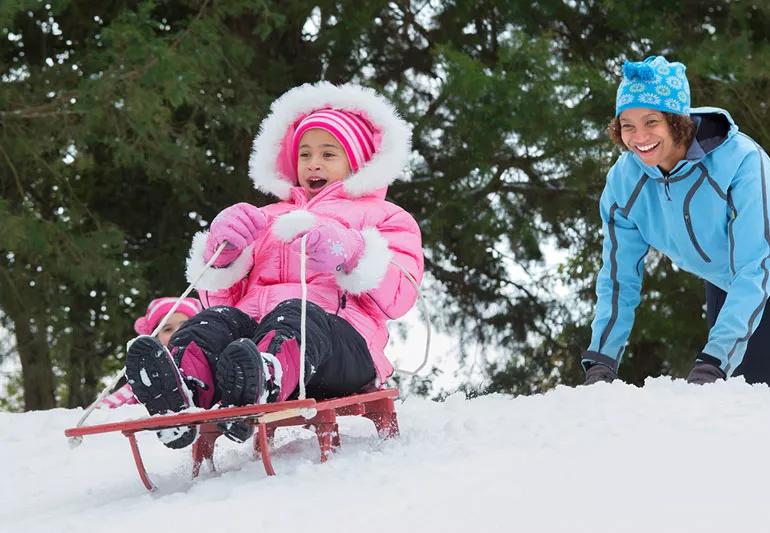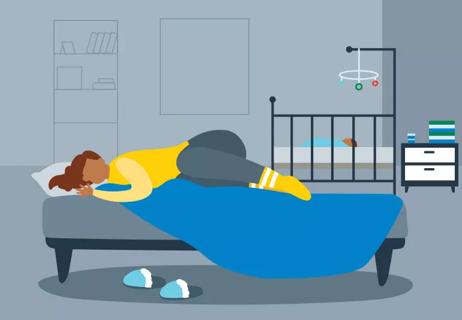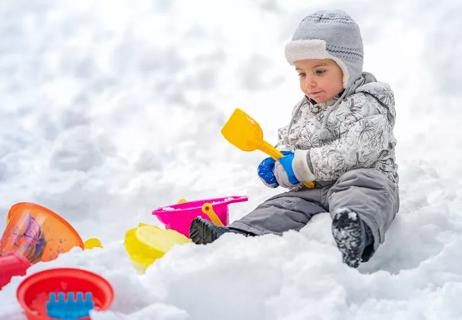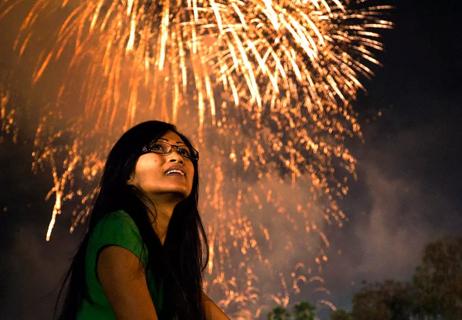An ER doc shares tips for being careful while having fun

After a fresh snowfall, you’ve probably got a few fun seasonal activities in mind (after you’ve dug out your car, that is). And if you live with little ones, there’s a good chance they’re going to ask to go sledding.
Advertisement
Cleveland Clinic is a non-profit academic medical center. Advertising on our site helps support our mission. We do not endorse non-Cleveland Clinic products or services. Policy
Sledding can be a lot of fun, but it also comes with plenty of risks. A 2021 study of sledding-related injuries showed that kids account for nearly 70% of sledding injuries, including fractures and concussions. In children and adults alike, the majority of injuries — as many as half — happen in collisions.
But that doesn’t mean you have to skip this wintry activity. Emergency medicine physician Baruch Fertel, MD, shares tips for safe sledding so you can enjoy your snow day and head home warm and well when you’re done.
The best time for sledding is right after a heavy, wet snowfall when the temperature is in the range of about 30 degrees Fahrenheit (or -1.1 degrees Celsius). Don’t go out in sub-zero temperatures, and avoid icy hills, which can be too slick to be safe.
Also avoid sledding at night, when visibility is low and you might not be able to see obstacles in your way.
Life is all about risk assessment: How can you do the things you want to do while remaining as safe as possible? Acknowledging some of the inherent risks that come with sledding, Dr. Fertel says a few simple safety precautions can go a long way into helping ensure a fun, injury-free day.
Scope out potential sled hills and pick one that’s free of trees and other potential dangers. After all, you’re going sledding, not slalom skiing! “The best thing people can do is pick a safe area that’s not too steep and doesn’t have a lot of obstacles,” Dr. Fertel says.
Advertisement
This includes making sure there’s ample room at the bottom to glide to a complete stop. Nix any hill that slides toward traffic, into a parking lot, near a body of water or toward anything other than a smooth, clear landing.
Suit up in waterproof gear intended for snow sports, and remove wet clothing as soon as you get home. “When your bottom layer of clothing gets soaked through, that can accelerate hypothermia and other cold-weather issues,” Dr. Fertel says.
As an added bonus, all that puffy snow gear provides an extra layer of padding that could go a long way in case of a crash landing.
You wear a helmet when you ride a bike; why not when you ride a sled? “The ideal kind of helmet is a winter sports helmet, but a bicycle helmet is better than nothing,” Dr. Fertel says.
Kids are more likely than adults to sustain head injuries while sledding, likely because they don’t have the skills to control their sleds as well. Kids’ heads are also larger in proportion to the rest of their bodies and thus more susceptible to injury.
To minimize your risk, choose a hill where your fellow sledders are observing the unwritten rules of the road. “It should be obvious where you sled down on one side of the hill and come back up on the other side,” Dr. Fertel says. “That separates people and prevents everyone from crashing into each other.”
If you ever stole — er, borrowed — a cafeteria tray from your college dining hall to hit the best hill on campus, you may be considering similar substitutions now. But the safest kind of sled is, well, an actual sled.
Studies show that sledders who use snow tubes and disks or saucers are more likely to sustain concussions than those who use sleds and toboggans. “The best type of sled is the kind with a steering mechanism and a brake,” Dr. Fertel explains, “and you want to be sure to use it the way the manufacturer says.” This means not loading multiple people onto a sled intended for one.
It can be tempting to build snow ramps (or to be the cool adult who sleds off the ramp that kids have made), but leave the stunts to the professionals. “Stick to sledding the way sledding is meant to be enjoyed,” Dr. Fertel advises, “and stay away from anything that involves flying through the air.”
All that snow might seem soft and fluffy, but the impact of coming down off of a ramp can cause serious injuries, including broken bones and head injuries.
Again, basics are best. Instead of sliding down headfirst, stick to feet-first sledding, for safety’s sake. “You have more control over the sled, and there’s less risk of a head injury if you do crash,” Dr. Fertel says.
Advertisement
A face full of powder is preferable to a broken bone, so teach kids to bail off of their sled if it’s moving too fast, or if it’s headed for an obstacle like a tree or another person. It’s much safer to bail than brace for a crash.
Kids can’t always communicate what they’re experiencing, especially when it comes to health issues. Dr. Fertel says to be on the lookout for any changes in behavior or appearance that might indicate a problem.
Kids who are having fun outside may not want to admit just how cold they are. Keep an eye out for signs that it’s time to come inside, like shivering, chattering or wet clothing that’s soaked through to the skin.
Call your pediatrician or head to the emergency room if your child starts exhibiting warning signs of frostbite or hypothermia, even after they’ve warmed up:
If your child gets into a sled crash, monitor them closely for any side effects, even if they seem OK at first. Head to the emergency room if they:
Advertisement
Following these tips can help ensure that sledding is a fun, memorable and safe way to spend your snow day.
Advertisement
Learn more about our editorial process.
Advertisement

Experts recommend having infants sleep in your bedroom but not in your bed

Have a snow — ball and help them strengthen their developmental skills

Tips for clearing your snow more safely

Candles release hydrocarbons into the air, but don’t pose a significant health risk

Tips for a fun, safe holiday for adults and children

Type 2 diabetes isn’t inevitable with these dietary changes

Applying a hot or cold compress can help with pain